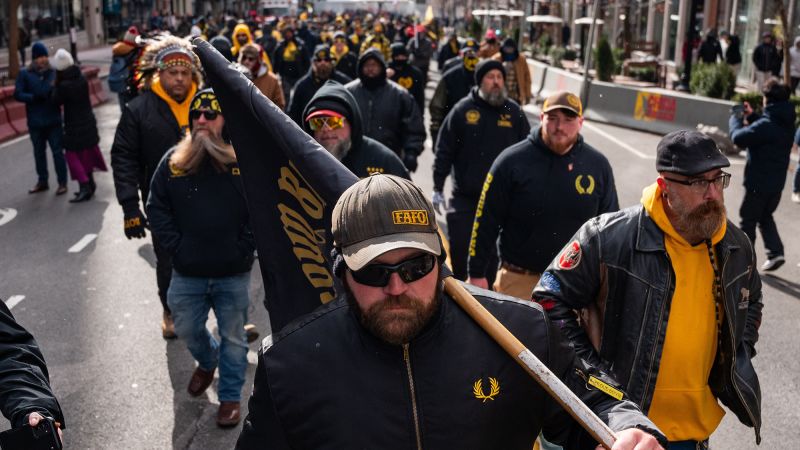London
—
When right-wing protestors took to the streets of London in September, the turnout was one of the largest in decades. More than 110,000 people showed up to rally against immigration, many carrying flags of England and Britain as they scuffled with police. But alongside the Union Jack and St George’s Cross, another symbol was unexpectedly visible: the logo belonging to the Italian fashion brand Stone Island.
A nautical star and compass overlaid on a button-on cloth badge with green, yellow and black detailing, the design frequently appears on Stone Island’s clothes — and during the protest, they were worn by Stephen Yaxley-Lennon, the far-right anti-Islam activist and English Defence League co-founder better known as Tommy Robinson, who had organized the march. The logo also appeared on the clothes of protestors and several high-profile Robinson supporters, such as the English podcaster Liam Tuffs.
It wasn’t the first time that Robinson — a former member of the British National Party, who has multiple criminal convictions for assault, financial and immigration frauds — has been seen wearing the label. Robinson has been photographed wearing the brand on several occasions, including in June, when he showed up at a magistrates’ court on charges of harassment and causing fears of violence, and at another far-right rally last July. (Robinson has entered not-guilty pleas for the June charges and a five-day trial in October 2026 has been set.)
Brands have limited control over the individuals that buy and wear their clothes. Robinson and his supporters have not claimed to use the Stone Island logo or its clothes as a symbol for far-right views. However, their apparent preference for wearing Stone Island has not gone unnoticed.
Robinson’s pseudonym is derived from a prominent member (with the same name) of the Men In Gear organization associated with the Luton Town Football Club. “He came out of that world, with all the clothing that comes with it,” said Joe Mulhall, the director of research at Hope not Hate, a UK-based advocacy group against racism and neo-fascism, citing brands like Stone Island and CP Company (the two share the same founder). “I can’t think of a time when he hasn’t worn those at public events.”
However, at a time when violence across the political spectrum is on the rise globally, brands “should be wary of being associated with groups or movements that promote, celebrate, or have been engaged in violence, no matter the ideology that motivates it,” said Dr. Cynthia Miller-Idriss, a Washington, DC-based sociologist and professor in The American University’s School of Public Affairs and in the School of Education. Stone Island and its parent company, Moncler Group, did not respond to CNN’s requests for comment.
Stone Island isn’t the only label to have been worn by people associated with extremist movements in recent years.
The Italian brand Loro Piana, which is owned by the world’s biggest luxury group LVMH, saw one of its $14,000 parkas worn by Russia’s president Vladimir Putin during a televised 2022 rally on Russian state TV, as he celebrated the country’s invasion of Ukraine. The jacket was identified by public observers and Loro Piana was heavily criticized on social media for not condemning Putin. Loro Piana declined to comment.

In some cases, specific designs from fashion brands have been co-opted by political groups as their uniforms. In 2020, the British sportswear label Fred Perry temporarily pulled one of its signature polo shirts in black and yellow stripes after it became associated with the Proud Boys, a far-right organization in the US.
The unwanted endorsement led one of Fred Perry’s ambassadors, “Trainspotting” author Irvine Welsh, to say that he would no longer wear the brand’s clothing because it had been adopted by the self-described “western chauvinist” group, despite his long-standing appreciation for the brand’s subcultural ties. The company has repeatedly distanced itself from the Proud Boys, describing them in a statement on its website as “counter to our beliefs and the people we work with.”

In 2016, a neo-Nazi website declared New Balance sneakers “the official shoes of white people” and encouraged its supporters to buy them, “so we will be able to recognize one another by our sportswear.” At the time, the US sportwear company, which is headquartered in Boston, responded by posting on its social media accounts, including Facebook and X, that it “does not tolerate bigotry or hate in any form.”
The American University’s Miller-Idriss traces the earliest uses of popular fashion brands as political symbols to early 1990s Germany, which saw a sharp rise in far-right street movements and violence following the fall of the Berlin Wall and subsequent reunification.
During this time, neo-Nazi gangs grew visible at concerts, football matches and in public squares. But, as the state banned overt Nazi symbols under Germany’s strict anti-Nazi laws, and swastikas and SS runes became illegal, extremists turned to coded clothing as a workaround, notably co-opting two brands, New Balance and Lonsdale, in the process.
“New Balance became a staple because the big ‘N’ stood for neo-Nazis, so in the summer they’d swap out combat boots for New Balance sneakers,” Miller-Idriss told CNN during a a phone interview.

Meanwhile, British sportswear brand Lonsdale’s blocky logo on T-shirts unintentionally contained a Nazi reference. “If they zipped their bomber jacket halfway, you would see the letters ‘NSDA,’ evoking the first four letters of the German initials of Nazi Party, but if the police stopped them, they could just unzip the jacket and it was an innocent Lonsdale T-shirt,” Miller-Idriss said. Clothes therefore became a clever signifier that could be displayed or concealed depending on the situation.
Intriguingly, in more recent decades, political and extremist groups have shifted away from a more provocative look, like skinheads, towards a more pedestrian aesthetic involving khakis and polo shirts. Miller-Idriss recalls seeing a style guide from a former prominent neo-Nazi blog stating that “people will be more likely to listen to our ideas if they like the package it comes in.” In that regard, “fashion became the new camouflage,” she said.
Founded in 1982 in the northern Italian town of Ravarino by designer Massimo Osti, Stone Island is known for its garment-dyeing expertise and technical fabrics, seen via products like its thermo-sensitive jackets, which change color in response to temperature. Its clothing doesn’t come cheap — a nylon tunnel down hooded jacket costs $1,075 — but its investment in material innovation and appreciation of (and ability to intertwine with) modern culture has contributed to its enduring popularity.
Owned by the Moncler Group, the brand has been charting a course forward under CEO Robert Triefus, who joined in May 2023 from Gucci. While Stone Island’s 2024 revenues of €401.6 million (about $471 million) was down 1% from the previous year, the sentiment around the label has been largely positive thanks to its savvy brand positioning and meaningful ties with subcultural communities globally.

Take for example, its ad campaign released in September 2024 featuring Oasis frontman Liam Gallagher, cleverly timed to the band’s reunion announcement and Gallagher’s status as a long-time fan. (The singer, who received his first Stone Island parka aged 7, famously took his prized jackets by the brand on tour in 2017, only to have them stolen.) The marketing initiative last fall placed Stone Island on the Lyst Index, a quarterly report that ranks the buzziest brands and products in fashion.
These days, the brand counts fans as varied as the actor Jason Statham, filmmakers Steven Spielberg and Spike Lee, rappers Drake, Kano, and Dave, the soccer player Erling Haaland, heavyweight boxing champion Oleksandr Usyk, and even the British prime minister Keir Starmer. Its female fanbase is also growing and includes the pop star Dua Lipa and the DJ and songwriter Peggy Gou.
Much of Stone Island’s loyalty, however, has historically stemmed from its roots in football culture, where its iconic compass badge has become a symbol of belonging, exclusivity, and identity for fans — particularly among the 1990s British “casuals” (also known as terrace culture), when a significant number of young men attending soccer matches wore the likes of Burberry, Fred Perry, Lacoste, and Ellesse, instead of team-specific clothing, as a way to express social status and tribal identity while eluding police and rival fans. (Many die-hard football fans were also part of other subculture groups, such as the skinheads, who were largely associated with violence. By dressing in expensive sportswear instead of their usual wardrobe staples, these individuals — often dubbed as hooligans — could easily slip past police on patrol, who sought to prevent violent outbreaks between rival teams.)
Stone Island’s former association with hooliganism may be attractive to some extremists, whose members share the same feelings of pride and connection, explained Miller-Idriss. Among ardent soccer fans, it’s part-and-parcel to have strong feelings against the opposing team, and the need to defend one’s turf and club. Many far-right groups reframe this tribalist thinking as their nation versus outsiders.
This is arguably the case with Robinson and his penchant for Stone Island. “It’s a status symbol, an expensive product, which is the very basis of why people wear it in the first place on the terraces — to show off,” said Ollie Evans, the UK-based founder and creative director of vintage reseller-turned-creative agency Too Hot. By wearing Stone Island, Evans said Robinson may be “signaling that he’s the top boy” — British slang for someone at the top of a social hierarchy.
While the launch of the Premiere League, the UK’s professional soccer association, in 1992 has led to the sport becoming increasingly regulated and “family friendly,” according to Dr. Tim Ellis-Dale, a senior lecturer in history at Teesside University in Middlesborough, the terrace hooligan scene that once adopted Stone Island has largely faded — though some of that past identity has lingered in the brand’s reputation.”
The rise of the internet and social media means that brands have significantly less control of their narrative, but for Miller-Idriss, there are ways to circumvent messaging that doesn’t align with their values. Lonsdale, for example, combated its negative association with neo-Nazis and far-right groups by sponsoring anti-racist events and initiatives, such as its memorable 2003 “Lonsdale Loves All Colours” campaign, which emphasized non-white fashion models and “helped reclaim the brand,” said Miller-Idriss. She also suggests brands can donate a portion of their profits to causes that “stand for their values.”

Crucially, the goal is to not alienate a brand’s core fanbase — which, in the case of Stone Island, hasn’t appeared to have been the case. Evans said he wasn’t thwarted by the brand’s adoption among Robinson and other political figures because of their lowbrow tastes. “It’s not just about the jacket he’s wearing; it’s how he wears it,” Evans explained, citing Robinson’s preference for distressed jeans and logo-heavy sneakers.
Evans adds that Stone Island’s Osti was a staunch supporter of the political left, an active member of the Italian Communist Party, and even served as a city councilor in Bologna. “If all these people adore him and still celebrate his work to this day — 20 years after he passed — someone like Robinson wearing it is not going to affect that,” Evans said.




